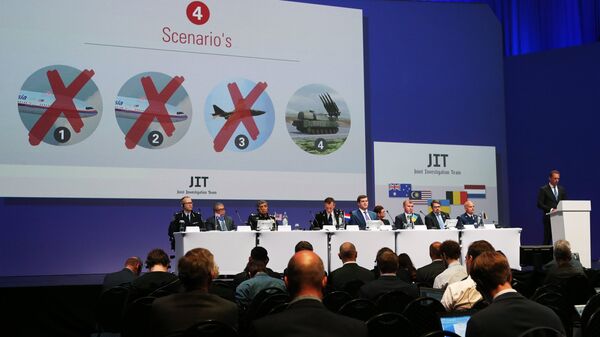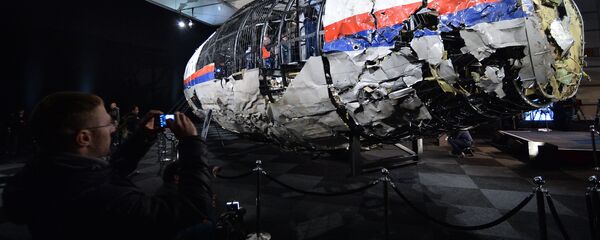MOSCOW (Sputnik) — The flight MH17 crashed in eastern Ukraine in July 2014 while flying to Kuala Lumpur from Amsterdam. All 298 passengers and crew aboard the aircraft died in the incident. The Ukrainian government forces and the local militias traded accusations regarding the incident, which occurred at the time of heavy fighting in the region.
The Dutch-led Joint Investigation Team (JIT) tasked with probing the crash announced in September that the MH17 airliner was allegedly downed by a Buk missile system, which they claimed had been brought from Russia and consequently returned there.
The Russian Defense Ministry cast doubt on the conclusions of the investigators, saying that no Russian missile systems, including Buk, have crossed the Russian-Ukrainian border at the time of the incident.
Decoding Unconventional Format Like Reading Egyptian Without Rosetta Stone
"The format is like the language used for the data. If they [Russia] use an unconventional format, not supported by this kind of tools, and they do not document it properly, it would be a very difficult problem to find the format and recover the data. It is like trying to read Egyptian without the Rosetta stone," Dr. Juan Besada, an engineering expert from the Technical University of Madrid, told Sputnik.
According to Besada, the process of decoding could have taken just minutes, given it was stored in a usual format.
"It is extremely dependent on the data format. If it is recorded in a well-documented and usual format it could be decoded and analyzed in minutes or hours, and all details of a flight might be inspected in few days," the engineering expert argued.
However, programming a decoder so it is capable to read this "unconventional" format might take Dutch investigators months, the expert said.
No Int'l Requirements Exist
Although Russia’s Federal Air Transport Agency (Rosaviatsia) did not specify which format was used when transferring primary radar data to the Netherlands, the agency pointed out that there were no international requirements regarding the list of such information and formats of recording.
"There is not a standard. For Air Traffic Control ASTERIX is becoming a standard, which is used in Western Europe (Eurocontrol affiliates, such as The Netherlands) and other countries. You should be aware that two of the most relevant Air Traffic Control producers, Indra and Thales, are European, so this format is also used in many other countries," Besada confirmed.
Another expert, Gaspare Galati, mirrored this view, stating that decoding radar data in other formats can be long depending on the documentation available and on software tools available for each format.
"The most common format for civil radar data, due to EUROCONTROL, is called ASTERIX and includes both radar plots and radar tracks, making easy their exchange. The European Air traffic Services (ATS) organizations use it. I do not know about Russia," Galati, Full Professor of Radar at University of Rome Tor Vergata, told Sputnik.
It remains unclear if the interface of one of the radar and control system production plants of the Russian defense manufacturer Almaz-Antey, which recorded the radar data from the MH17 flight crash site in July 2014, is compliant with ASTERIX, but the company states its Topaz Air Traffic Control (ATC) System conforms with standards of the International Civil Aviation Organization (ICAO).
"I am aware many years ago Indra (Spanish produced of Air Traffic Control systems) worked in developing some systems in Russia, and they were astonished to see how different some things were. But I am talking about 15-20 years ago. I imagine now the Russian systems would be much more similar to European ones and much more interoperable," the Spanish engineering expert explained.
However, Russia's VNIIRA, the long-standing developer of the automated air traffic control systems, states that its systems developed in the ninetieths and early 2000th years are fully satisfying the EUROCONTROL recommendations and compliant with ASTERIX.
No Request for Help
As a usual practice, the provider of radar data and the transcriber have to cooperate to extract the useful information, Jesus Garcia Herrero, Associate Professor at the Charles III University of Madrid’s Computer Science Department, told Sputnik.
"The information you give me does not surprise me, from my experience it is very necessary the collaboration of industrial radar provider to extract the useful data (details of data format, meaning of fields, configuration, etc.). The software to do that, 'radar data extractor,' is very depending on the physical characteristics and configuration of installation," Herrero said.
The need for the Netherlands and Russia to collaborate on this deciphering task was also noted by Juan Besada.
Meanwhile, Wim de Bruin, spokesman for the Dutch state prosecutor’s office, refused to specify whether the Netherlands would ask Russian specialists to help decode the radar data from the MH17 crash site.
"These questions cannot be answered. Legal requests are confidential," Wim de Bruin told Sputnik on Monday.
However, he confirmed the Netherlands would send a supplementary request for legal assistance to Russia.
In its turn, Russia stands ready to dispatch its experts and the needed information "so that the entire public learns the truth about the tragedy," Rosaviatsia deputy chief Oleg Storchevoy told reporters.




